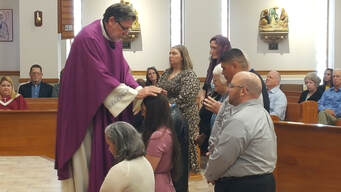Becoming Catholic
RCIA
OPENING THE DOORS TO THE CATHOLIC FAITH
RCIA deepens relationships with Jesus Christ and understanding of the Catholic Church, its teachings, and living a Christian life.
What is RCIA?
RCIA stands for Rite of Christian Initiation for Adults. It is the process of coming into full communion with the Catholic Church (“converting” to Catholicism). The intent of the process is to develop an individual’s faith formation within the framework of the Church community. The RCIA process allows participants to grow in their faith as well as their understanding of Catholic teachings so they are able to make an informed and responsible commitment to the Church. RCIA consists of two parts (“semesters”) known as the Period of Inquiry (participants are known as Candidates) and the Catechumenate (participants are known as Catechumens). RCIA culminates with the Easter Vigil Mass the night before Easter when the Catechumens are accepted fully into the church through the sacraments of baptism (if not previously baptized), confirmation, and eucharist.
RCIA stands for Rite of Christian Initiation for Adults. It is the process of coming into full communion with the Catholic Church (“converting” to Catholicism). The intent of the process is to develop an individual’s faith formation within the framework of the Church community. The RCIA process allows participants to grow in their faith as well as their understanding of Catholic teachings so they are able to make an informed and responsible commitment to the Church. RCIA consists of two parts (“semesters”) known as the Period of Inquiry (participants are known as Candidates) and the Catechumenate (participants are known as Catechumens). RCIA culminates with the Easter Vigil Mass the night before Easter when the Catechumens are accepted fully into the church through the sacraments of baptism (if not previously baptized), confirmation, and eucharist.
What to Expect?
The RCIA process is comprised of four phases with each phase focused on coming to know the Lord more deeply. The person seeking to join the Church is introduced to beliefs, life, liturgy and ministry in the Catholic community.
Period of Evangelization and Pre-Catechumenate
This is a time, of no fixed duration or structure, for inquiry and introduction to Gospel values, an opportunity for the beginnings of faith.
Period of the Catechumenate
This is the time, in duration corresponding to the progress of the individual, for the nurturing and growth of the catechumens’ faith and conversion to God; celebrations of the Word and prayers of exorcism and blessing are meant to assist the process.
Period of Purification and Enlightenment
This is the time immediately preceding the elects’ initiation, usually the Lenten season preceding the celebration of this initiation at the Easter Vigil; it is a time of reflection, intensely centered on conversion, marked by celebration of the scrutinies and presentations and of the preparation rites on Holy Saturday.
Period of Postbaptismal Catechesis or Mystagogy
This is the time, usually the Easter season, following the celebration of initiation, during which the newly initiated experience being fully a part of the Christian community by means of both penitent catechesis and particularly by participation with all the faithful in the Sunday Eucharistic celebration.
Period of Evangelization and Pre-Catechumenate
This is a time, of no fixed duration or structure, for inquiry and introduction to Gospel values, an opportunity for the beginnings of faith.
Period of the Catechumenate
This is the time, in duration corresponding to the progress of the individual, for the nurturing and growth of the catechumens’ faith and conversion to God; celebrations of the Word and prayers of exorcism and blessing are meant to assist the process.
Period of Purification and Enlightenment
This is the time immediately preceding the elects’ initiation, usually the Lenten season preceding the celebration of this initiation at the Easter Vigil; it is a time of reflection, intensely centered on conversion, marked by celebration of the scrutinies and presentations and of the preparation rites on Holy Saturday.
Period of Postbaptismal Catechesis or Mystagogy
This is the time, usually the Easter season, following the celebration of initiation, during which the newly initiated experience being fully a part of the Christian community by means of both penitent catechesis and particularly by participation with all the faithful in the Sunday Eucharistic celebration.
What is meant by coming into full communion with the Church?
Coming into full communion with the Catholic Church describes the process for entrance into the Catholic Church for already baptized Christians. In most cases, these individuals make a profession of faith but are not baptized again. To prepare for this reception, the people, who are called Candidates, usually participate in a formation program to help them understand and experience the teachings and practices of the Catholic Church. Although some preparation may be with Catechumens preparing for baptism, the preparation for Candidates is different since they have already been baptized and committed to Jesus Christ, and many have also been active members of other Christian communities. The Candidates may be received into the Catholic Church at the Easter Vigil or at another Sunday during the year depending on pastoral circumstances and readiness of the Candidate.
What does the white robe symbolize?
The newly baptized are dressed in a white garment after baptism to symbolize that they are washed clean of sin and that they are called to continue to walk in this newness of life.
What does the candle symbolize?
A small candle is lit from the Easter candle and given to the newly baptized as a reminder to them always to walk as children of the Light and to be the light of Christ to the world.
What does the Sacred Chrism symbolize?
The Sacred Chrism, or oil, is a sign of the gift of the Holy Spirit being given to the newly baptized. It is also a sign of the close link between the mission of Jesus and the outpouring of the Holy Spirit, who comes to the recipient with the Father in Baptism.
Why was this ancient rite restored?
It was restored in the Church to highlight the fact that the newly baptized are received into a community of faith, which is challenged to realize that they too have become different because of this new life in the community.
Is there a ceremony or preparation for Catholics who never or seldom have practiced the faith?
For Catholics who have been Baptized, Confirmed and made First Communion but then drifted from the faith, the way they return is through the Sacrament of Penance. Catholics who were baptized but never received Confirmation and/or Eucharist also participate in a period of formation. This process of formation is completed with the reception of the Sacraments of Confirmation and Holy Communion often at the Easter Vigil or during the Easter Season.
What is the role of a godparent for an adult being baptized?
Prior to the Rite of Election, the Catechumen may choose one or two godparents, who will accompany the Catechumen on the day of Election, at the celebration of the Sacraments of Initiation, and during the Period of Mystagogy. They are called to show the Catechumens good example of the Christian life, sustain them in moments of hesitancy and anxiety, bear witness, and guide their progress in the baptismal life.
What does the white robe symbolize?
The newly baptized are dressed in a white garment after baptism to symbolize that they are washed clean of sin and that they are called to continue to walk in this newness of life.
What does the candle symbolize?
A small candle is lit from the Easter candle and given to the newly baptized as a reminder to them always to walk as children of the Light and to be the light of Christ to the world.
What does the Sacred Chrism symbolize?
The Sacred Chrism, or oil, is a sign of the gift of the Holy Spirit being given to the newly baptized. It is also a sign of the close link between the mission of Jesus and the outpouring of the Holy Spirit, who comes to the recipient with the Father in Baptism.
Why was this ancient rite restored?
It was restored in the Church to highlight the fact that the newly baptized are received into a community of faith, which is challenged to realize that they too have become different because of this new life in the community.
Is there a ceremony or preparation for Catholics who never or seldom have practiced the faith?
For Catholics who have been Baptized, Confirmed and made First Communion but then drifted from the faith, the way they return is through the Sacrament of Penance. Catholics who were baptized but never received Confirmation and/or Eucharist also participate in a period of formation. This process of formation is completed with the reception of the Sacraments of Confirmation and Holy Communion often at the Easter Vigil or during the Easter Season.
What is the role of a godparent for an adult being baptized?
Prior to the Rite of Election, the Catechumen may choose one or two godparents, who will accompany the Catechumen on the day of Election, at the celebration of the Sacraments of Initiation, and during the Period of Mystagogy. They are called to show the Catechumens good example of the Christian life, sustain them in moments of hesitancy and anxiety, bear witness, and guide their progress in the baptismal life.








